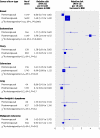Cancer incidence and mortality in relation to body mass index in the Million Women Study: cohort study
- PMID: 17986716
- PMCID: PMC2099519
- DOI: 10.1136/bmj.39367.495995.AE
Cancer incidence and mortality in relation to body mass index in the Million Women Study: cohort study
Abstract
Objective: To examine the relation between body mass index (kg/m2) and cancer incidence and mortality.
Design: Prospective cohort study.
Participants: 1.2 million UK women recruited into the Million Women Study, aged 50-64 during 1996-2001, and followed up, on average, for 5.4 years for cancer incidence and 7.0 years for cancer mortality.
Main outcome measures: Relative risks of incidence and mortality for all cancers, and for 17 specific types of cancer, according to body mass index, adjusted for age, geographical region, socioeconomic status, age at first birth, parity, smoking status, alcohol intake, physical activity, years since menopause, and use of hormone replacement therapy.
Results: 45,037 incident cancers and 17 203 deaths from cancer occurred over the follow-up period. Increasing body mass index was associated with an increased incidence of endometrial cancer (trend in relative risk per 10 units=2.89, 95% confidence interval 2.62 to 3.18), adenocarcinoma of the oesophagus (2.38, 1.59 to 3.56), kidney cancer (1.53, 1.27 to 1.84), leukaemia (1.50, 1.23 to 1.83), multiple myeloma (1.31, 1.04 to 1.65), pancreatic cancer (1.24, 1.03 to 1.48), non-Hodgkin's lymphoma (1.17, 1.03 to 1.34), ovarian cancer (1.14, 1.03 to 1.27), all cancers combined (1.12, 1.09 to 1.14), breast cancer in postmenopausal women (1.40, 1.31 to 1.49) and colorectal cancer in premenopausal women (1.61, 1.05 to 2.48). In general, the relation between body mass index and mortality was similar to that for incidence. For colorectal cancer, malignant melanoma, breast cancer, and endometrial cancer, the effect of body mass index on risk differed significantly according to menopausal status.
Conclusions: Increasing body mass index is associated with a significant increase in the risk of cancer for 10 out of 17 specific types examined. Among postmenopausal women in the UK, 5% of all cancers (about 6000 annually) are attributable to being overweight or obese. For endometrial cancer and adenocarcinoma of the oesophagus, body mass index represents a major modifiable risk factor; about half of all cases in postmenopausal women are attributable to overweight or obesity.
Conflict of interest statement
Competing interests: None declared.
Figures



Comment in
-
Obesity and cancer.BMJ. 2007 Dec 1;335(7630):1107-8. doi: 10.1136/bmj.39384.472072.80. Epub 2007 Nov 6. BMJ. 2007. PMID: 17986715 Free PMC article.
-
Increasing BMI was associated with increasing risk for overall cancer incidence and mortality in middle-aged women.ACP J Club. 2008 May 20;148(3):13. ACP J Club. 2008. PMID: 18489076 No abstract available.
References
-
- World Health Organization. Obesity: preventing and managing the global epidemic: report of a WHO consultation on obesity, Geneva, 3-5 June 1997 Geneva: WHO, 1998 - PubMed
-
- Department of Health. Health survey for England 2004: updating of trend tables to include 2004 data London: DH, 2005
-
- Calle EE, Thun MJ, Petrelli JM, Rodriguez C, Heath CW. Body mass index and mortality in a prospective cohort of U.S. adults. N Engl J Med 1999;341:1097-105. - PubMed
-
- Flegal K, Graubard B, Williamson D, Gail M. Excess deaths associated with underweight, overweight, and obesity. JAMA 2005;293:1861-7. - PubMed
-
- Manson JE, Willett WC, Stampfer MJ, Colditz GA, Hunter DJ, Hankinson SE, et al. Body weight and mortality among women. N Engl J Med 1995;333:677-85. - PubMed
Publication types
MeSH terms
Grants and funding
LinkOut - more resources
Full Text Sources
Medical
